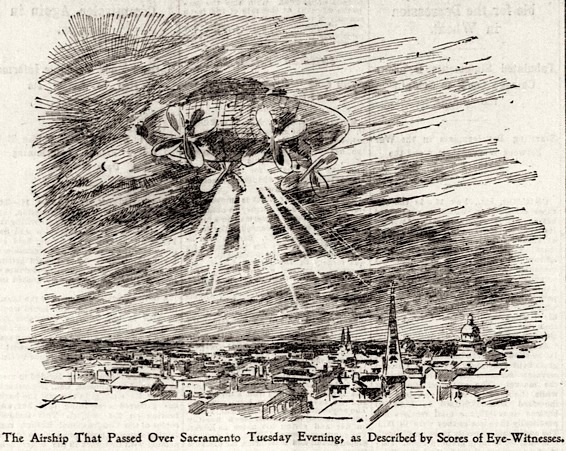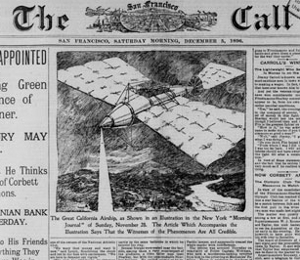“When we remember we are all mad, the mysteries disappear and life stands explained.”
–Mark Twain
Glance up at the sky: during the day you’ll see clouds and the sun – and at night it’s the moon and stars. But what most folks don’t realize is that what they are also gazing up at is (metaphorical) ink blotches on white paper.
You see, for many the sky is a kind of a Rorschach test: when faced with something up there we can’t quite figure out we humans will transform it into something we can — through a filter of the age and the technology we happened to be living in at the time.
Who knows what early man saw when they looked up … but in the Middle Ages angels and demons cartwheeled across the sky, during the Second World War foo fighters and Swedish ghost rockets were secret Nazi weapons, in the 1950s it was all flying saucers and Little Green Men…
And in the 1800s the craze was to see mystery airships.
In 1896, for instance, both the San Francisco Call and the Sacramento Bee reported wrote of a unknown flying machine that one night buzzed the California State capital. A Mr. R. L. Lowery described it as a pedal-powered dirigible – sporting a passenger compartment – operated by two men. Lowery also said that he could head someone on board bark orders to climb to avoid colliding with either a church steeple … or a local brewery (depending on who was asked). Mr. Lowery wasn’t the only witness, however: others were quoted as having heard singing from the craft as it floated overhead.

The craft returned five days later. A Mr. Zemansky observed the machine – or, rather, “an electric arc light of intense power” that vanished to the southwest after taking half an hour to bob and float its way across the city. Whatever it was, it made pretty good time because it popped up again 90 minutes later in San Francisco where it was observed by hundreds of witness – one of being the mayor. San Franciscans weren’t the only ones to have to see the craft: one report noted that it had used it’s “electric arc light of intense power” to scare the wildlife of Seal Rock.
From California, the craft seems to have moved to the Midwest: Nebraska, specifically, being its next port-of-call. In 1897 Hastings was visited by the airship … followed three days later in Invale. Somewhere in it’s voyages it was spotted by a farmer when it seemingly needing to land and undergo repair: “It is cigar shaped, about 200 feet long and 50 feet across at the widest point, gradually narrowing to a point at both ends,” he said.
From the Cornhusker State, it apparently floated to Kansas. It was in the little hamlet of Le Roy that we have one of the best accounts of the airship – and perhaps the dietary requirements of its crew. Alexander Hamilton, a farmer and not the Founding Father, saw the craft drop down onto his farm where it rather clumsily lassoed a cow, only to have it caught in some fencing. Hamilton told others that while he couldn’t cut the cow lose he did manage to free the ship, after which he “stood in amazement to see the ship, cow and all rise slowly and sail off.”
Chicago seems to have been the fantastic ship’s next destination. In early April the city reported it being buzzed by the craft – its strange lights seen by over a hundred witnesses. After getting a bit bored with the city, it visited Wisconsin next, where yet another farmer told of receiving a letter from ship telling of its’ construction in – of all places – Tennessee. Shortly thereafter, more correspondences appeared, many of them – if you can believe it – quite dubious.
The most famous of these letters, though, was the one discovered in Astoria, Illinois. Written to Thomas Edison, the note was apparently a coded message to the great inventor from the pilot of the craft. No doubt sworn to secrecy, Edison’s evasive answer to the letter was to claim it was a “pure fake.”
Even though a lot of these reports had the crew of the craft – or crafts – as human, the world of the late 1900s was open enough to allow for other possibilities. According to the April 19, 1987 Dallas Morning News an airship crashed into one Judge Proctor’s sump pump, in Aurora. Witnesses told of the deceased pilot – who was subsequently given a Christian burial – as “not an inhabitant of this world.”
 One of the more interesting other-worldly accounts, though, came nine days before. The April 10th, 1897, St. Louis Post-Dispatch featured a story of a Mr. W. H. Hopkins’s experience with a mystery craft near Springfield, Missouri. He told of a machine 20 feet long, 8 feet in diameter and driven by three propellers and piloted by a man and a woman … in the nude. Apparently having a difficult time communicating with them, Hopkins was finally able to get across his question regarding their point of origin. To which they pointed up and “uttered something that sounded like the word Mars.”
One of the more interesting other-worldly accounts, though, came nine days before. The April 10th, 1897, St. Louis Post-Dispatch featured a story of a Mr. W. H. Hopkins’s experience with a mystery craft near Springfield, Missouri. He told of a machine 20 feet long, 8 feet in diameter and driven by three propellers and piloted by a man and a woman … in the nude. Apparently having a difficult time communicating with them, Hopkins was finally able to get across his question regarding their point of origin. To which they pointed up and “uttered something that sounded like the word Mars.”
While mysterious airships faded pretty quickly from the press after 1897, new accounts appeared soon after in other countries – most notably Great Britain – as late as 1913.
But, in the end, the truth of it is that when some people look up at the skies they far too often report more about their hopes, dreams, and even nightmares than what actually might be up there.
#
*On a cinematic side note, be sure and check out one the very earliest science fiction films for a taste of airship wonderfulness: Luftkrieg Der Zukunft, (The Battle in the Clouds as it was called in the US) directed by Walter R. Booth back in 1909.











